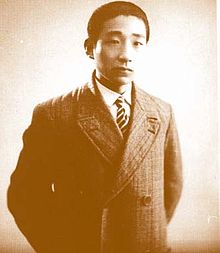At Shizhang
Bei Shizhang ( Chinese 贝 时 璋 / 贝 时 璋 , Pinyin Bèi Shízhāng , W.-G. Pei Shih-chang ; born October 10, 1903 in Zhenhai, Zhejiang Province , Chinese Empire ; † October 29, 2009 in Beijing , People's Republic of China ) was a Chinese biologist , biophysicist, and educator . He was a member of the Chinese Academy of Sciences . Shizhang is considered a pioneer of Chinese cell biology and embryology and the "father of Chinese biophysics".
biography
Bei Shizhang was born into a fishing family in the small coastal town of Zhenhai ( 镇海 ) in Zhejiang Province. He was the first in his family to receive formal schooling. He attended German mission schools, where he came into contact with the German language at an early age. Bei then studied at the Tongji Medical and Engineering School ( 同济 医 工 学堂 ) in Shanghai, which was also founded in 1907 under German direction. In 1921 he finished his studies and went with two fellow students to Europe by ship to continue his education there. The three fellow students chose the Albert-Ludwigs-Universität Freiburg because their Chinese degrees were recognized there. The two fellow students Beis, Yu Hongkang ( 余鸿康 ) and Li Yuanshan ( 李元善 ) chose the medical faculty, while Bei enrolled in the natural sciences faculty. At that time, Hans Spemann , the botanist Friedrich Oltmanns , the physicist Franz Himstedt , the chemist Heinrich Otto Wieland taught at the natural science faculty, and the anatomist Eugen Fischer and the pathologist Ludwig Aschoff, among others, taught at the medical faculty . In 1922 Bei moved to Munich in the hope of being able to do a doctoral thesis there with the zoologist Richard Hertwig . In Munich he attended lectures in chemistry with Richard Willstätter , physics with Wilhelm Wien , botany with Karl von Goebel , paleontology with Ferdinand Broili, geology with Emmanuel Kayser . Since Hertwig was about to retire, he recommended Bei Shizhang to his colleague Friedrich Blochmann in Tübingen. In Tübingen, Bei initially worked as a research assistant on experiments on cell constancy of the parasites Oxyuris obvelata and O. tetraptera . Ultimately, Jürgen Wilhelm Harms became Bei's doctoral supervisor. Harms represented a neo- Lamarckism and believed in the inheritance of acquired traits. Bei Shizhang was also influenced by these views. In 1928 he received his doctorate in Philosophy in Tübingen for his work on experimental morphological investigations on nematodes .
From 1933 to 1949 he was dean of the Faculty of Biology at the University of Zhejiang , which had to relocate several times due to the Sino-Japanese War (to Jiangxi , Guangxi and most recently Guizhou ) and, despite the unfavorable circumstances, built it into one of the most scientifically active research centers for Biology in China. From 1950 to 1954 he was director of the Institute for Experimental Biology of the Chinese Academy of Sciences (CAW), and later founding director of the Institute for Biophysics of the CAW.
On the occasion of his 100th birthday, the asteroid 31065 Beishizhang was named after him. At the time of his death, Be was the oldest member of the Academia Sinica and the Chinese Academy of Sciences.
Web links

Selected publications
- Sitsan Pai (Bei Shizhang): The phases of the life cycle of the Anguillula aceti Ehrbg. and their experimental-morphological influence . In: Z. Wiss. Zool. tape 131 , 1928, pp. 293-344 .
- Sitsan Pai (Bei Shizhang): Diploid intersexing in Chirocephalus nankinensis . In: [Scientific Reports from Zhejiang University] . tape 1 , 1942, p. 187-197 .
- Sitsan Pai (Bei Shizhang): 卵黄 粒 与 细胞 之 重建 (Cellular renewal of yolk granules) . In: 科学 (Ke Xue) . tape 26 , 1943, pp. 38-49 (Chinese).
- At S (Sitsan Pai): About the transformation of the genital cells in chirocephalus intersexes . In: [Scientific Reports from Zhejiang University] . tape 2 , 1943, p. 573-583 .
- Shizhang Bei (Ed.): 细胞 重建 (第一集) (" Cell Renewal I") . Wissenschaftsverlag (科学 出版社), Beijing 1988 (Chinese).
- Shizhang Bei (Ed.): 细胞 重建 (第二集) (" Cell Renewal I") . Wissenschaftsverlag (科学 出版社), Beijing 2003 (Chinese).
Individual evidence
- ↑ a b Christine Yi Lai Luk: A History of Biophysics in Contemporary China . In: Springer Briefs in History of Science and Technology . ISBN 978-3-319-18092-2 , ISSN 2211-4564 , chap. 2: The Father of Biophysics in China, p. 11–32 , doi : 10.1007 / 978-3-319-18093-9 (English, PDF ).
- ↑ The oldest Tübingen alumnus lives in China. Uni-Online.de, August 28, 2007, archived from the original on October 21, 2011 ; accessed on March 2, 2019 .
- ^ Pei-Sung Tang: Biology in war-time China . In: Nature . tape 154 , no. 3897 , July 8, 1944, p. 44 (English, pdf ).
- ^ Laurence Schneider: Biology and Revolution in Twentieth-Century China . Rowman & Littlefield Publishers, Inc., 2005, ISBN 0-7425-5306-X , pp. 111 (English).
- ↑ Guyan Wang: Shizhang Bei (Sitsan Pai) and his theory of cell reformation . In: Protein Cell . tape 1 , no. 4 , April 1, 2010, p. 315-318 , doi : 10.1007 / s13238-010-0050-x (English).
| personal data | |
|---|---|
| SURNAME | Bei, Shizhang |
| ALTERNATIVE NAMES | 贝 时 璋 (Chinese) |
| BRIEF DESCRIPTION | Chinese biologist, biophysicist and educator |
| DATE OF BIRTH | October 10, 1903 |
| PLACE OF BIRTH | Zhenhai, Zhejiang Province , Chinese Empire |
| DATE OF DEATH | October 29, 2009 |
| Place of death | Beijing , People's Republic of China |
